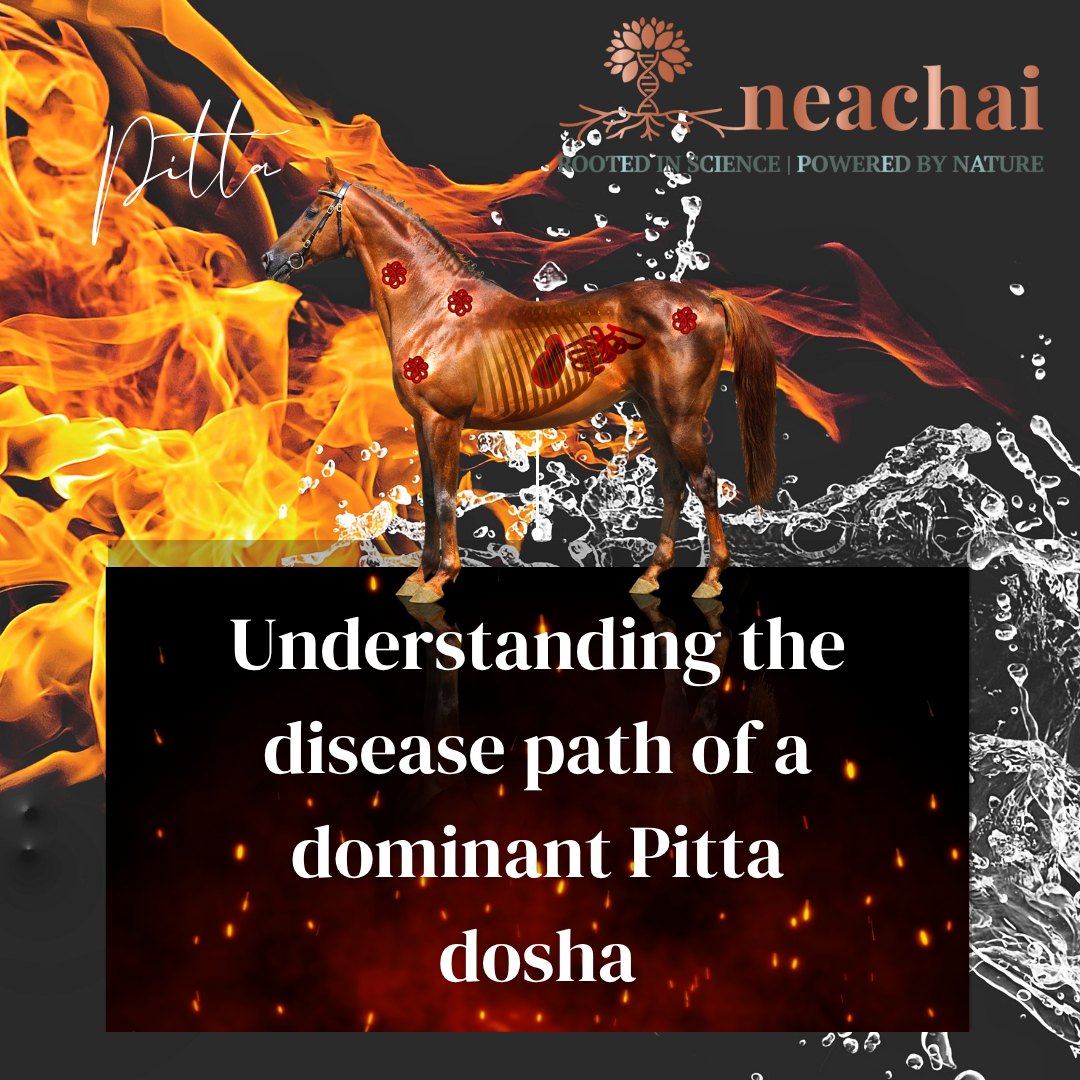Last time I shared with you the disease path of the Vata dosha, this
week we will cover Pitta. What the disease expressions look like in your pitta animal and the ultimate disease progression if not treated.
In Ayurveda, the six types of Rasa (taste), Guna (property), Karma (action), Virya( potency), Vipaka (post digestive effect) play a critical role in identifying the stage of disease as well as targeting the area of dysfunction.
In short, how the body reacts to tastes starts to paint the picture of dosha aggravation or pacification. The properties of the substance indicate what organ and cell will be targeted, and the post digestive effect will determine the nourishment of the individual cell body. The qualities of each dosha are critically important as it would be counter intuitive to give a substance that is heating to a pitta. Like increases like, opposites create balance. Knowing these taste, action and properties of foods and herbs we can ensure the lifestyle and disease management protocol is in alignment with your animals’ physical predispositions.
The fire and water properties of Pitta dosha make these characteristics hot, spicy, and passionate. If pitta comes out on top as the primary dosha in your animal’s unique combination of doshas, these physical and biological processes will be involved.
√ Brain and heart
√ Eyes (rod and cone cells)
√ Skin
√ Plasma and blood
√ Liver and spleen
√ Alimentary Canal (hind gut)
When systemic imbalance arises in the body, the tastes and actions of food and herbs can either help restore harmony or further aggravate the imbalance. In particular, the sour taste can irritate the gut, leading to discomfort around the umbilical area, intense hunger, and discolored urine.
As the imbalance deepens, the hot and pungent qualities mix with sour and liquid attributes, often resulting in acid indigestion, hyperacidity, heartburn, nausea, and gastric pain. At this stage, the doshas become vitiated and begin to affect various organs. The small intestine becomes overburdened, and if not addressed properly, the disease will no longer remain localized in the gastrointestinal tract—it will begin to migrate to other tissues throughout the body.
This progression starts with the plasma (rasa) and blood (rakta) channels. The oily quality associated with Pitta aggravates these pathways, promoting systemic spread. The entry of disease into the plasma—a system composed of serum, white blood cells, and the lymphatic network—should be taken seriously. In both humans and animals, this can manifest as chronic hives, dermatitis, persistent rashes, irritated melanin cell hotspots, and even skin cancers like malignant melanoma, a dangerously metastasizing condition.
If you suspect cancerous, itchy moles or abnormal growths on your horse or dog, contact your veterinarian immediately to assess and potentially remove them.
If the disease continues untreated or is improperly managed, it will infiltrate the rakta dhatu or blood tissue, which includes red blood cells. The hot and sharp qualities of aggravated Pitta at this stage may cause bleeding disorders, reduced platelet counts, and impaired blood clotting. Blood becomes thinner and more prone to rupturing vessels. Inflammatory conditions such as rheumatoid arthritis may also develop as uric acid levels rise and form crystals that irritate joint membranes. Skin conditions like eczema or weeping dermatitis are also common.
Should the condition persist, it will next affect the mamsa dhatu or muscle tissue. Inflammatory disorders such as bursitis, and recurring abscesses may appear. As it moves into the meda dhatu, or fat tissue, one may observe excessive sweating, cystitis, and intense thirst. An overload of Pitta in the fat tissues can impair liver function, leading to fatty liver changes. Because of the link between fat metabolism and the endocrine system, autoimmune diseases involving the adrenal glands and thyroid may also emerge.
As Pitta progresses to the asthi dhatu (bone tissue), structural issues arise. Inflammatory changes may affect the periosteum and bone matrix, leading to dental abscesses, gum disease, hair loss, and hoof problems. Swelling and heat in the joints may occur, and Ayurveda recognizes a direct relationship between ulcerative colitis and osteoarthritis.
Once Pitta reaches the majja dhatu, or nerve tissue, symptoms may include burning sensations, depression, demyelinating disorders, encephalitis, and even behavioral changes such as aggression. Since one of Pitta’s sub-doshas governs the eyes, you may also see increased tear production or disorders like uveitis. Pitta also influences the reproductive system, potentially causing erratic estrous cycles and behavioral shifts in mares, or issues like reduced semen motility in stallions.
Understanding your horse’s dosha can help you recognize their mental, physical, and biological constitution. By identifying early signs of imbalance, you can often intervene through short-term dietary and lifestyle changes. Remember, in Ayurvedic philosophy, "like increases like": dry qualities increase Vata, heat increases Pitta, and heavy, oily qualities increase Kapha. Recognizing these patterns empowers you to support your horse’s health naturally and prevent deeper issues from developing.

